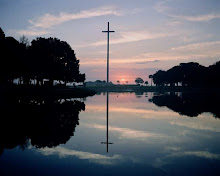
I stopped at the graveyard on the way home from picking her up from school. We were looking for a grave marker. Something that would tell us who was buried there. We wanted to find one that included the name Joseph. We took separate paths and looked for about ten minutes before finding it. A clear marker letting all know that Joseph was buried here. It is certain that those who knew Joseph well also knew where this marker was. They knew where the tomb was because they knew who Joseph was.
Sometimes when we are reading scripture we overlook simple details that are rather mundane. Below is one example of such a mundane detail:
Joseph of Arimathea, a respected member of the Council, who was also himself looking for the kingdom of God, took courage and went to Pilate and asked for the body of Jesus. Pilate was surprised to hear that he should have already died. And summoning the centurion, he asked him whether he was already dead. And when he learned from the centurion that he was dead, he granted the corpse to Joseph. And Joseph bought a linen shroud, and taking him down, wrapped him in the linen shroud and laid him in a tomb that had been cut out of the rock. And he rolled a stone against the entrance of the tomb. Mary Magdalene and Mary the mother of Joses saw where he was laid.
(Mark 15:43-47)
There are a few things that we can note about this simple burial story. First to note is that Joseph was a member of the Council. This means that he was a member of the group that helped to send Jesus to His death. It is not likely that Joseph would have been a Christian invention. The resurrection claims could have been refuted quite simply with claims from the Jewish leaders that there was no such person. We do not have any records of such claims from the Jewish leaders.
In fact, we can go further to say that there are actually no competing burial stories at all. The silence of the Jews on this matter speaks loudly to the truth of the Gospel narrative. If Jesus were not buried in the tomb of Joseph then we would know. There would be some record claiming that He had been buried elsewhere but there are none. This may seem like a rather mundane detail but why is it important?
The earliest records we have are claims from the Jewish leaders that the disciples stole the body. Why would they make this claim? There was something that they were trying to explain. Something that they refused to believe but has given people hope for 2000 years. Think back to my trip to the graveyard. If the friends and relatives of that Joseph knew where he was buried, then how many more people would know where the tomb of a member of the Council would be? How many of them do you think went and checked the claims of the women and the disciples? How many of them were at a loss to explain how the body of a dead man could go missing? So they make up a story to try to keep the masses quiet.
Their story gives us a certain fact about the resurrection account. The lack of a competing burial story testifies to its truth. The standing of Joseph in the community completes our knowledge of one thing with certainty on that Sunday morning 2000 years ago.
The tomb was empty. Praise God, He is risen!


No comments:
Post a Comment